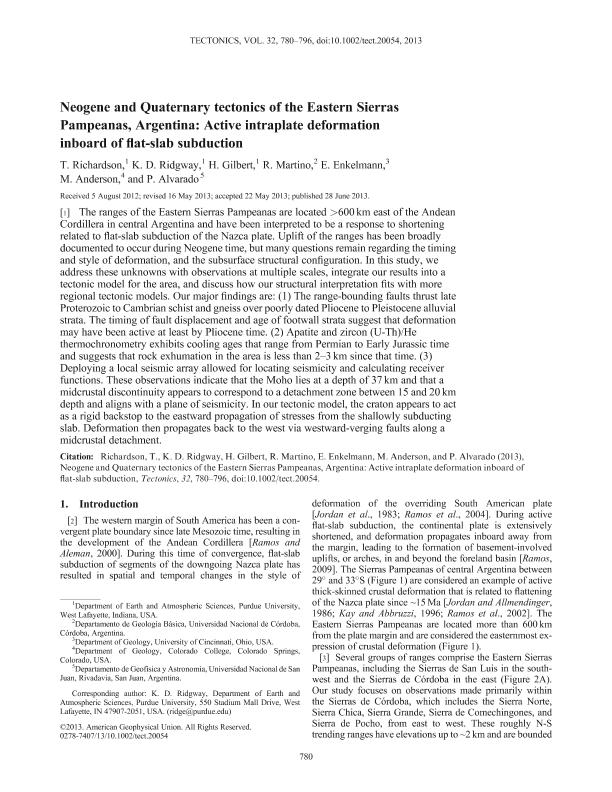Artículo
Neogene and Quaternary tectonics of the Eastern Sierras Pampeanas, Argentina: Active intraplate deformation inboard of flat-slab subduction
Richardson, T.; Ridgway, K.; Gilbert, Hersh; Martino, Roberto Donato ; Enkelmann, E.; Anderson, M.; Alvarado, Patricia Monica
; Enkelmann, E.; Anderson, M.; Alvarado, Patricia Monica
 ; Enkelmann, E.; Anderson, M.; Alvarado, Patricia Monica
; Enkelmann, E.; Anderson, M.; Alvarado, Patricia Monica
Fecha de publicación:
28/06/2013
Editorial:
American Geophysical Union
Revista:
Tectonics
ISSN:
0278-7407
Idioma:
Inglés
Tipo de recurso:
Artículo publicado
Clasificación temática:
Resumen
The ranges of the Eastern Sierras Pampeanas are located >600 km east of the Andean Cordillera in central Argentina and have been interpreted to be a response to shortening related to flat-slab subduction of the Nazca plate. Uplift of the ranges has been broadly documented to occur during Neogene time, but many questions remain regarding the timing and style of deformation, and the subsurface structural configuration. In this study, we address these unknowns with observations at multiple scales, integrate our results into a tectonic model for the area, and discuss how our structural interpretation fits with more regional tectonic models. Our major findings are: (1) The range-bounding faults thrust late Proterozoic to Cambrian schist and gneiss over poorly dated Pliocene to Pleistocene alluvial strata. The timing of fault displacement and age of footwall strata suggest that deformation may have been active at least by Pliocene time. (2) Apatite and zircon (U-Th)/He thermochronometry exhibits cooling ages that range from Permian to Early Jurassic time and suggests that rock exhumation in the area is less than 2-3 km since that time. (3) Deploying a local seismic array allowed for locating seismicity and calculating receiver functions. These observations indicate that the Moho lies at a depth of 37 km and that a midcrustal discontinuity appears to correspond to a detachment zone between 15 and 20 km depth and aligns with a plane of seismicity. In our tectonic model, the craton appears to act as a rigid backstop to the eastward propagation of stresses from the shallowly subducting slab. Deformation then propagates back to the west via westward-verging faults along a midcrustal detachment. Key Points The ESP is actively deforming, possibly in relation to flat-slab subduction.Our analyses of fault outcrops and local seismicity clarify crustal structure.Results from our analyses yield insights into local intraplate deformation.
Palabras clave:
Seismicity
,
Tectonics
,
Earthquakes
Archivos asociados
Licencia
Identificadores
Colecciones
Articulos(CCT - CORDOBA)
Articulos de CTRO.CIENTIFICO TECNOL.CONICET - CORDOBA
Articulos de CTRO.CIENTIFICO TECNOL.CONICET - CORDOBA
Articulos(SEDE CENTRAL)
Articulos de SEDE CENTRAL
Articulos de SEDE CENTRAL
Citación
Richardson, T.; Ridgway, K.; Gilbert, Hersh; Martino, Roberto Donato; Enkelmann, E.; et al.; Neogene and Quaternary tectonics of the Eastern Sierras Pampeanas, Argentina: Active intraplate deformation inboard of flat-slab subduction; American Geophysical Union; Tectonics; 32; 3; 28-6-2013; 780-796
Compartir
Altmétricas



